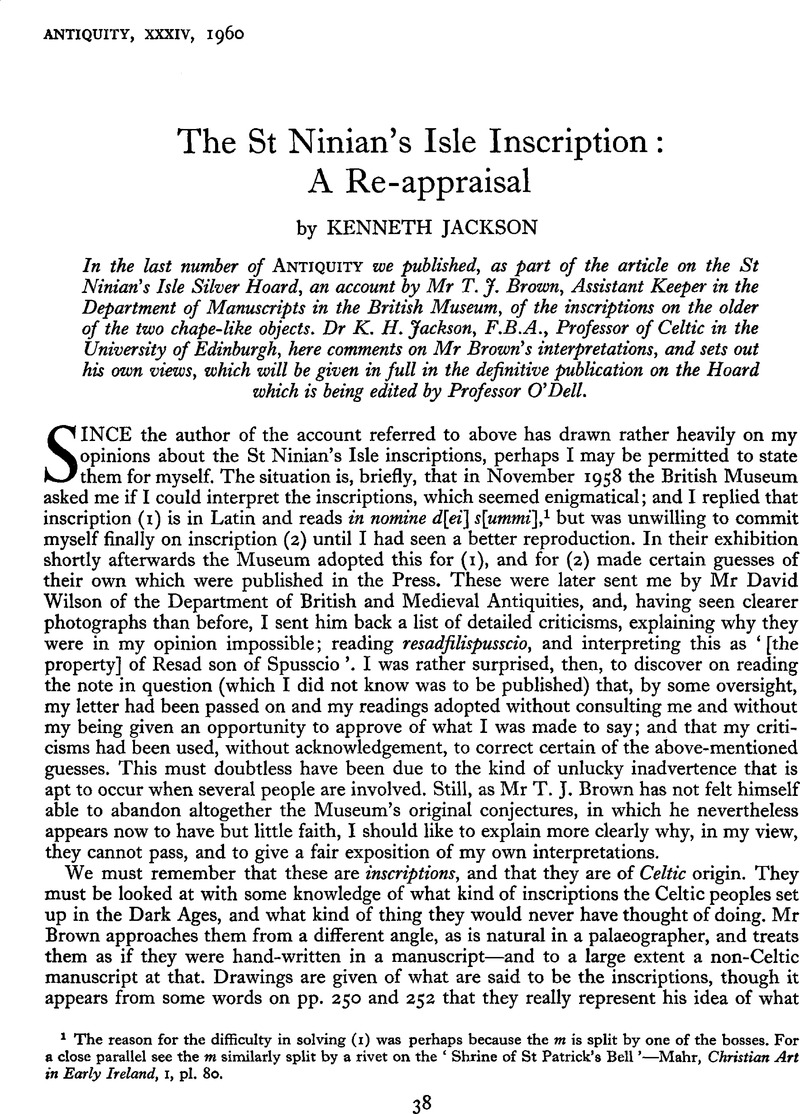Published online by Cambridge University Press: 02 January 2015

1 The reason for the difficulty in solving (1) was perhaps because the m is split by one of the bosses. For a close parallel see the m similarly split by a rivet on the ‘Shrine of St Patrick’s Bell’—Mahr, Christian Art in Early Ireland, I, pl. 80.
2 The resemblance to the actual inscriptions is particularly remote in the case of (2). It is regrettable that no drawings were given to show what they are really like; it is scarcely relevant what they would look like in a manuscript. See FIG. 1.
3 Though at the same time it is doubted (on rather curious grounds) whether he was ‘literate’.
4 See Macalister, Corpus Inscriptionum Insularum Celticarum, II, Nos, 1060, 1064, and 1062 (all wrongly numbered in his plates).
5 See Nash-Williams, Early Christian Monuments of Wales, No. 287.
6 As Mr Brown remarks, drawing on my letter.
7 See Nash-Williams, op. cit. fig. 188, 4, and pl. XXIII. On the date see Ifor Williams in Archaeologia Cambrensis, Vol. 100 (1949), 162. Williams’ plate shows that Nash-Williams’ drawing of the b is not quite correct.
8 The deep splits in the f and s’s remind one of the s on the Llantwit Major Samson cross, among others.
9 Miswritten ni.
10 Nash-Williams, op. cit. Nos. 220 and 240; he dates them respectively late 9th and 11th century.
11 See A. W. Clapham in ANTIQUITY VIII (1934), 49; probably 7th century.
12 National Museum of Antiquities, Edinburgh; perhaps 8th century.
13 Op. cit. Nos. 223, 233, and 237, dated by him 10th-11th or 11th century.
14 Nash-Williams No. 72 ; the drawing in Gibson’s Camden suggests 7th or 8th century.
15 Nash-Williams No. 255; he dates it 11th century.
16 Archaeologia Cambrensis 1899, p. 144.
17 Op. cit. 11, No. 1020.
18 Op. cit. No. 200. See also Archaeologia Cambrensis XCIV (1939), 16-17, where he dates it late 10th-11th century.
19 As Mr Brown does not say clearly that dei stimmi is my interpretation, not his, I must note that his in nomine deus is not mine and would never have occurred to me.
20 In Pictish ones ‘X meqq Y’ may occur.
21 N.B.—This objection applies equally to Mr Brown’s Adkil, Resadfil, etc. etc.
22 Mr Brown apparently thinks the owner may have been a Shetlander, but I know no reason for this. The idea might be taken, from the wording on his p. 253, to derive from myself; which is not the case.
23 The whole thing was doubtless regarded as a continuation of in nomine dei summi, and if resad and o had not been there, and two et’s had been, it would have been convincing. The ‘filler’ is a council of despair; and the entire formula as it stands would be unique, not to say extraordinary.
24 The k must in any case be wrong.
25 Celtic names in Latin inscriptions of this period do not add Latin -is, hence if the above interpretations were right they would have to be Resadfilis, Adkilis, etc., not Resadfil, Adkil, etc.
26 I am indebted to the Rev. Professor John Ryan, who kindly confirms the first of these points and states the second.
27 In fact there is no reason to believe that it did belong to a priest, and hence arguments based on a supposed clerical ownership are misconceived.
28 But the contraction for this word in Celtic sources is prsb.